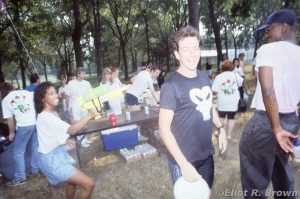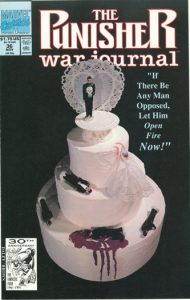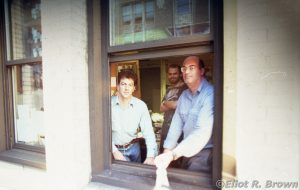Welcome back to this installment of Interviews from Behind The Universe by Nicholas Brown. We plan to be here the first and third Monday of every month bringing you classic Marvel bullpen stories from the old crew. Today’s guest is Editor and Writer extraordinaire and an old friend of Eliot’s, Don Daley!
Don was The Punisher editor while Eliot was doing the Punisher Armory and while relationships between Writers and Editors can be a bit touch and go sometimes there was no hostility between these two. At least not permanently.
I’ve heard many people talk about my father in his younger days, and god help me, I’ve grown up with him talking about himself but nobody has yet captured the surreal insanity of his character like Don Daley. Clearly it takes one to know one.
Before we start, here’s a quick shout out for an organization Don cares deeply about, Sidewalk Samaritan. https://www.sidewalksamaritan.org/.
They collect and give out socks, coats and various necessities to people living on the street and that’s especially important with the coldest months coming up soon so please consider donating if you’re able.
And now to delve once more into Marvel’s history, here’s Don Daley.
Q: What did you do before working at Marvel Comics and do you think that helped prepare you for the job?
Before I worked for Marvel, I worked for United Artists distributing films; worked in the garment industry; worked as a projectionist in an art movie cinema; worked in restaurants, was a security guard, worked in a gym, raked leaves, delivered papers, mowed lawns, built water features, worked as a crepe chef, baby sat, shoveled snow, landscaped, copy edited on a newspaper, cooked in a dining hall, worked at a gas station, summarized newspapers for a New York State governor, ghost wrote, painted houses, lots of other jobs I’ve forgotten.
What helped me from those experiences was being able to learn quickly, figure out a job quickly. It also helped to have been in different situations, locations, with different types of people, so that I was able to draw upon those experiences as creative fodder when and if a writer could use help. And seeing a lot of film—at one point in my life I was seeing roughly 10 films a week…and at another point in my life, I saw the same film or films roughly five times in a week. That kind of concentrated viewing helps build a library of visual possibility, story possibility…and helps you come up with more than one way to tell a story.
I also think that playing in bands from an early age, seeing a lot of live music, and hitch-hiking and driving long distances to shows, helped me feel very comfortable with people who were creative, who loved what they were doing, who were fans of the whole medium. My impression of Marvel was that these people felt about comics the way I felt about music, and I was amazed at how many visual artists also were musicians.
I couldn’t pencil, or color, or letter, or ink. I didn’t know comics continuity, or the History of the Marvel Universe. But I knew what I liked, and I could explain why I liked it, and over time, with a lot of help from Denny O’Neil and Larry Hama, I started to understand story in a way that I previously had not. And that understanding has enriched my life ever since then, and I’m grateful for having had this experience working in comics.
Q: What has life been like after Marvel?
Life after Marvel has been, as it was before Marvel, during Marvel, and now, after Marvel, a mixed bag.
For me, the big event after Marvel was having a kid. That kid, my daughter, is now 16, has a boyfriend, helps me on jobs sometimes, drives (I taught her), and is a hard-working, intelligent, good, kind, fun person.
I’ve traveled a bit, worked doing different things. I was fortunate to work with Van Morrison and Dr. John, as well as some other bands I love. I continue to see a lot of live music, film, and comedy. I opened my own little consulting company and paint (walls and ceilings, not “art” painting!) and landscape…I’m chipping away at writing four different novels, and I have an idea I’m developing for a series of books.
I miss many of the people I worked with in comics, but some of my very favorite people have died (Christine Slusarz, and Mark Gruenwald, for example). I still talk with and see some Marvel people, but it’s hit-and-miss, mostly: people are spread out, busy, doing different things, for the most part.
In addition to missing the specific experience of helping produce five or six monthly comic books, I miss the experience of working with creative people who love what they’re doing. I get that sometimes in my life, but not all the time, as it was at Marvel.
Q: What projects are you working on now?
I’m working on several novels…hope to renovate an old movie theatre…and am curating some “music tours” with friends and family (we see three bands in three cities in three nights and eat at three different old-time diners).
Q: Is there anything you miss about the old comic industry compared to the way things are now?
I don’t really follow the comic industry that much now, at least not in the way I did when I worked in it, so it’s difficult for me to say much on this topic. I do get the sense from friends still working in comics that much of the “physicality” that I loved about comics is gone…meaning some people produce the drawings on a computer, send them via computer, color them on a computer, etc. It’s gone from very much being a “face-to-face,” kind of walk-in operation to being more of a digital/remote thing, from what I understand of it.
Much of the trend toward digital was starting just at the end of my time in comics. I really loved holding a page of original art……there was something timeless about knowing that it had been a blank sheet of paper, and different people had spent hours and in some cases days turning that blank into something that could advance plot, reveal character, maybe even move the reader to tears or laughter or reflection or wonder.
Q: What lead you to get into the comic industry in the first place?
I lived in a big brownstone in Prospect Heights, Brooklyn, back in the early 80s with five other people, including one guy, Bob DeNatale, who was working as Danny Fingeroth’s assistant up at Marvel. Bob was a drummer (as I am), and he worked days at Marvel, while playing in a band at night. We’d hang out at night and listen to and talk about music, and sometimes Bob had photocopies of comic book art lying around in his room.
I found the art beautiful, and the visual storytelling interesting. I’d read comics as a kid but had only focused on the art and story, not so much on the creators, or the process of creation. You just went into a drug store and comic books were on a spinner rack. That’s how I experienced comics as a kid.
So to suddenly understand that people produced something from nothing, and to see the nuts and bolts of it, and to know someone who was involved, was fascinating to me. And Bob was very willing to explain what he did, storytelling principles, what an inker did, what made certain artists great, etc., and I just found it all very intriguing.
And the production aspect—starting with literally nothing, then a writer takes a blank page, and starts to type, and then someone takes a pencil to a blank page, and an inker comes in with ink and suddenly what was in one person’s brain as a story idea and another person’s brain (often, unless it was a writer/artist genius like John Byrne or Frank Miller) as images, it’s suddenly lettered, and inked…and the ink and black placements give it weight, make it more real. We’re still talking about a representation of three dimensional reality on a two-dimensional surface, so the inker and colorist have to do a lot of heavy lifting, but every now and then, when the people click, when the story hits a nerve, you can make a reader laugh, make a reader cry.
At one point, Bob had left Marvel and said I should apply if I were interested. I gave him a resume, which floated around, until Linda Grant left Marvel, which meant Denny O’Neil needed an assistant. He interviewed me, we clicked, and that was how I got in.
Q: What was your first impression of Eliot?
Scientists say that humans have evolved to be biologically hard-wired for survival, and as part of this, we instinctively, unconsciously for the most part, do a “threat assessment” of anyone entering our visual field, and form an immediate impression.
Eliot made a big impression on not just me but everyone, because Eliot was a big man, tall, built like a fire hydrant, and loud. His voice and projection would be the envy of any stage actor. And not only was he imposing on a visual and auditory level, but he also was possessed of an air of authority, which, it turned out, was well deserved. I saw him tackle design, framing, construction and finish carpentry, photography, scripting, weaponry, sales, marketing, portfolio analysis, and what I saw was that if Eliot did it, he did it well. Here’s an example:
I don’t think of myself as a particularly creative guy, but one night I had a dream.
I dreamt an image, and I woke up and did a very crude sketch of it. In the morning, I looked at while having coffee, and thought, “This is actually an interesting idea, sort of an arresting idea, but how to execute?” I wanted to do a photo cover, to distinguish it from the typical drawn covers, and the first guy—the only guy, really, who I KNEW could grok the concept and run with it in the execution—was Eliot. He looked at my stupid little sketch, said, “Got it,” and left my office.
Two days later, Eliot walks in with a manila envelope, takes out a big transparency and shows me what we ended up printing as the cover to Punisher War Journal #36 (below). Eliot took an idea from my little crude sketch, built a model, tweaked it, and photographed what turned out to be one of my very favorite covers, not because I had an idea, but because I thought it was so striking visually.
Q: What was it like working with Eliot on The Punisher Armory?
Working with Eliot on the Punisher Armory was right up there in my best experiences at Marvel, alongside doing the Punisher War Journal with Jim Lee or the Punisher/Archie crossover with Batton Lash and John Buscema, or doing Captain America with Mark Gruenwald or the Batman/Punisher crossover with Denny O’Neil and Chuck Dixon and John Romita Jr. and Klaus Janson.
The Armory was Eliot’s baby…this guy could do technical drawing, understood comics, and loved hardware. There are some guys—Michael Golden, obviously comes to mind (he did some Armory covers), as does Herb Trimpe—who just love hardware, who can take a piece of metal, pick an angle, play with the layout, make it sexy, make it look powerful, and real, and Eliot had that talent in spades.
So having him choose hardware, create visually arresting images, and then add the Punisher’s “voice-over” was something that I appreciated editorially because he was spot on, just never needed any tweaking, and it was also something that I loved just as a Punisher fan.
The book we put out was 32 pages, no ads…and Eliot filled almost every page. Figure roughly 300 pages, maybe more, of technically accurate, beautifully laid out, lovingly rendered hardware. Plus brilliant narration by The Punisher himself, speaking directly to the reader.
I’ve edited books that I didn’t particularly respond to initially. I think that either it’s my nature, or it’s just natural, than any editor who looks closely at a property (as one must to edit that property), that editor begins to appreciate things about that property. Even if it’s not your favorite thing, you find things that work, find things you like, find things you wish there was more of, find things to shrink and twist and explore…and then you’re involved. And that helps you make the execution on that property better.
But with the Punisher, it was like, Hair Club for Men. You ever see that commercial, “I’m not just the President of Hair Club for Men, I’m also a CLIENT!”?
That was me with the Punisher. I’d loved Don Pendleton’s The Executioner series (that Gerry Conway had told me had helped inspire The Punisher), and I’d loved the Zeck/Beatty work as well. I love the whole retribution genre, whether it’s the Greeks, or Sergio Leone…or Jean Pierre Melville…and so to watch one guy come in with pages he conceived, researched, layed out, penciled, inked, scripted…to see what one man’s brain and hands and memory and creativity and talent could do in a single page, ostensibly talking about hardware, but simultaneously revealing character, IN A SINGLE PAGE, that was amazing to me.
I’m looking at hardware—there’s no human on the page, no puppy, no kitten, nothing soft, typically, all inanimate cold steel—and I felt the same way I did watching Jim Lee draw (and talk at the same time), or John Byrne draw (and talk at the same time!), or Mark Texeira lay out, or listening to Larry Hama plot—I felt like I was witnessing genius.
Not just talent: genius.
I’ve seen many artists at the top of their form: Stevie Ray Vaughan, Marcel Marceau, Les Paul, Billy Cobham, Doc Watson, Alison Kraus, Tony Rice, Darrell Scott, Tim O’Brien, NRBQ, I could go on and on. I’d put Eliot’s work on the Armory up there with them. Just perfect meshing of creator and creation.
Q: What is the most embarrassing story you have about my father?
I don’t think it’s so much embarrassing, as totally illegal.
But fun.
I had an office at the end of the hall, by the back elevators. I’m working late one night, Eliot pops his head in, says, Hey, come out on the landing, you’ll wanna see this. I go out on the landing, Eliot’s holding what appears to be a metal pipe. I say, what’s that and he explains, it’s a bean bag gun, a buddy loaned it to him to photograph and he just wants to try it out.
“Wonder how much kick this sucker’s got…” Eliot grips it with two hands, takes a firing stance, and blows a large hole in the drywall.
We laugh hysterically, and skedaddle back into my office.
That was Eliot in a nutshell: unpredictable, into things in a very committed, dedicated way, and fun to be around. You couldn’t do anything like that now, post-9/11. They’d have S.W.A.T. teams setting up perimeters and sending in robots.
One other story, or, rather, the Legend of Eliot.
I joined Marvel in 1984 and left in 1995. I think Eliot was fired at least five times, maybe more, during my tenure at Marvel. He and whoever was in charge would butt heads over something stupid and next thing you know, Eliot got his walking papers. Thing was, they never took.
Eliot just kept showing up, and doing interesting, great work, work that in many cases no one else had a clue how to do, so the pink slip never stuck to Eliot. He was a Human Resources Boomerang.
Wonderful guy, Eliot. Super-talented, and fun to be around.



